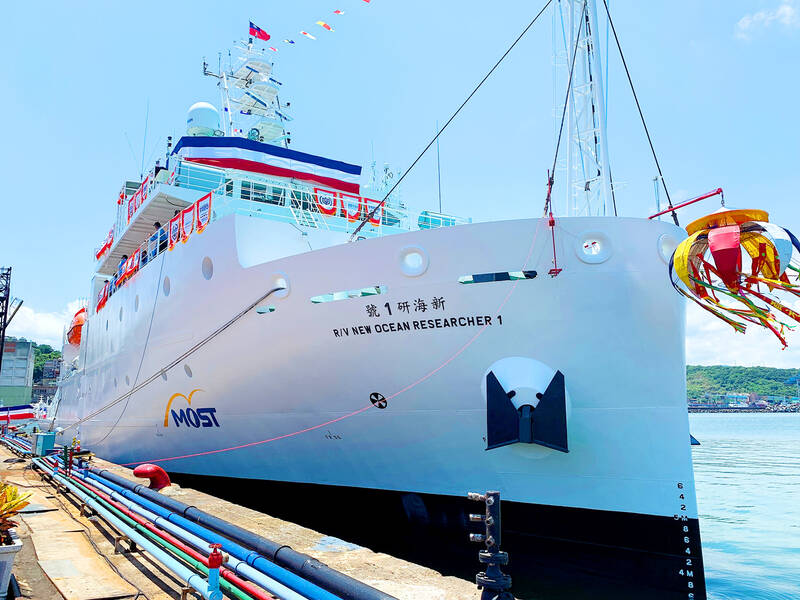The National Science and Technology Council said it would hold meetings with national security and coast guard officials before dispatching research vessels, after a legislator revealed that there have been 11 territorial conflict-related incidents involving research vessels over the past five years.
As Taiwan’s exclusive economic zone overlaps with those of other countries, including China and Japan, its research vessels are occasionally driven away by those countries’ coast guard ships.
At a legislative budget hearing on Wednesday, independent Legislator Huang Kuo-shu (黃國書) asked the council about its plan to handle harassment of research vessels.

Photo: Lin Hsin-han, Taipei Times
One incident occurred in late September when National Taiwan University-operated New Ocean Researcher 1 (新海研一號) was conducting research off eastern Taiwan, Huang said.
Believing it was operating in Japan’s exclusive economic zone, a Japanese coast guard ship issued a warning to the vessel, he said.
The Taiwanese coast guard sent its 500-tonne Hualien patrol boat as a precautionary measure, resulting in a 10-hour standoff, he added.
After the incident, the Chinese Ministry of Foreign Affairs made representations to Tokyo asking it not to interfere with “China’s research work,” Huang said.
Calling the incident “embarrassing,” Huang asked council Minister Wu Tsung-tsong (吳政忠) to respond, as well as restart the Taiwan-Japan Maritime Affairs Cooperation Dialogue.
Wu reiterated that China had no right to raise representations with Japan over the incident.
As a Taiwanese coast guard vessel arrived on the scene, Wu said he assumed that foreign affairs and national security personnel resolved the matter.
The annual Taiwan-Japan maritime dialogue has halted for nearly two years due to the COVID-19 pandemic, although it should restart now that the borders have opened, he added.
Huang said Taiwanese research vessels have been harassed by foreign ships 11 times over the past five years, citing council data.
In two incidents, the vessels were pursued by Chinese ships within 1 nautical mile (1.85km), he added.
Even a joint research project with the Philippines encountered harassment by Chinese ships, Huang said, adding that the Philippine government handled the issue.
Beijing’s increasingly aggressive gray area tactics have caused neighboring countries to raise their guard, affecting Taiwanese maritime research, Huang said, urging the government to review its navigation and notification mechanisms.
Wu said that incidents are not handled by the council alone, but in cooperation with the National Security Council, the coast guard and other agencies.
He vowed that that National Science and Technology Council would hold meetings with other agencies before research vessels are dispatched, to clarify the vessels’ tasks and procedures.

Beijing could eventually see a full amphibious invasion of Taiwan as the only "prudent" way to bring about unification, the US Department of Defense said in a newly released annual report to Congress. The Pentagon's "Annual Report to Congress: Military and Security Developments Involving the People's Republic of China 2025," was in many ways similar to last year’s report but reorganized the analysis of the options China has to take over Taiwan. Generally, according to the report, Chinese leaders view the People's Liberation Army's (PLA) capabilities for a Taiwan campaign as improving, but they remain uncertain about its readiness to successfully seize

Taiwan is getting a day off on Christmas for the first time in 25 years. The change comes after opposition parties passed a law earlier this year to add or restore five public holidays, including Constitution Day, which falls on today, Dec. 25. The day marks the 1947 adoption of the constitution of the Republic of China, as the government in Taipei is formally known. Back then the Chinese Nationalist Party (KMT) governed China from Nanjing. When the KMT, now an opposition party in Taiwan, passed the legislation on holidays, it said that they would help “commemorate the history of national development.” That

Trips for more than 100,000 international and domestic air travelers could be disrupted as China launches a military exercise around Taiwan today, Taiwan’s Civil Aviation Administration (CAA) said yesterday. The exercise could affect nearly 900 flights scheduled to enter the Taipei Flight Information Region (FIR) during the exercise window, it added. A notice issued by the Chinese Civil Aviation Administration showed there would be seven temporary zones around the Taiwan Strait which would be used for live-fire exercises, lasting from 8am to 6pm today. All aircraft are prohibited from entering during exercise, it says. Taipei FIR has 14 international air routes and

The Ministry of National Defense (MND) today released images of the military tracking China’s People's Liberation Army (PLA) movements during the latest round of Chinese drills around Taiwan. The PLA began "Justice Mission 2025" drills today, carrying out live-fire drills, simulated strikes on land and maritime targets, and exercises to blockade the nation's main ports. The exercises are to continue tomorrow, with the PLA announcing sea and air space restrictions for five zones around Taiwan for 10 hours starting from 8:30am. The ministry today released images showing a Chinese J-16 fighter jet tracked by a F-16V Block 20 jet and the